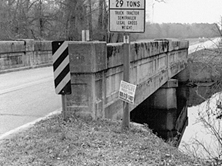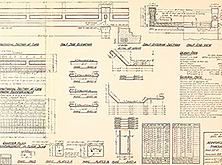 Girders extend above and below the deck at Wilson County Bridge 105, built in 1920 for the county following standardized state plans (source: NCDOT bridge inspection files).
Girders extend above and below the deck at Wilson County Bridge 105, built in 1920 for the county following standardized state plans (source: NCDOT bridge inspection files). Reinforced concrete through girder bridges are composed of a pair of cast-in-place longitudinal girders and a deck slab connected by steel reinforcing bars. The type could also be built with transverse floorbeams, but in North Carolina only deck slabs that required less complicated formwork were used.
The roadway passes between the paired girders, which are commonly very large — 18 to 30 inches in width and four to six feet in depth — and have deep inset panels to save on weight. The girders serve as the parapets as well as the main supporting members. Through girder bridges are often mistaken for slab bridges because of their similarity.
 The first standardized state plan sheet for a reinforced concrete through girder bridge, November 1919 (source: Third Biennial Report of the State Highway Commission of North Carolina, 1919-1920). Like other standardized reinforced concrete bridges, including the slab and tee beam, the through girder type appeared nationally in the first decade of the 20th century. In North Carolina the type does not appear to have been widely used until adopted as a standard design by the State Highway Department in 1920.
The first standardized state plan sheet for a reinforced concrete through girder bridge, November 1919 (source: Third Biennial Report of the State Highway Commission of North Carolina, 1919-1920). Like other standardized reinforced concrete bridges, including the slab and tee beam, the through girder type appeared nationally in the first decade of the 20th century. In North Carolina the type does not appear to have been widely used until adopted as a standard design by the State Highway Department in 1920.
It was one of the least successful of the early standardized types, mainly because it proved less economical than tee beams for the same range of span lengths, about 30- to 50-feet. It was limited to relatively narrow roadways of less than 24 feet.
Further, through girders were difficult to widen, a concern increasingly on the minds of bridge engineers in the late 1920s as automobiles and trucks increased in size and power. The type was listed in the department's published specifications through 1927, but did not appear in later editions, a good indication it had fallen out of favor.
County governments, which worked from the state standards, also made use of the design. Twenty-four through girders erected between 1920 and 1929 are known to have survived into the opening of the 21st century. The earliest, built in 1920, carries Bridgersville Road over Cattail Swamp outside Elm City (Wilson County Bridge 105).
Although its lifespan was brief, the standard through girder bridge design made a contribution to the development of the state highway system in the 1920s.